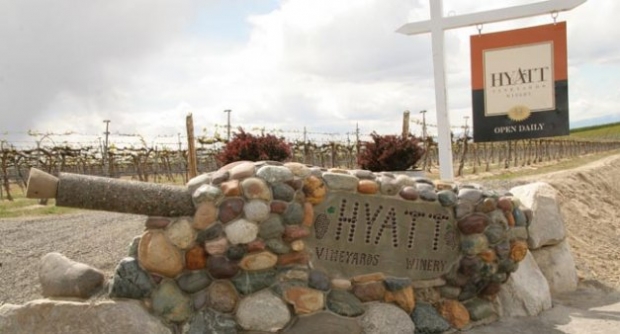
What appeared to be a normal wine tasting visit by two locals and two foreigners has turned into a surprising niche market for Zillah, Washington, wine producer Hyatt Vineyards in an even more surprising location.
The visit to Hyatt Vineyards by the four mystery tasters in 2009 was nondescript from Hyatt’s viewpoint. Tasting room staff members don’t remember the visit. But when the visitors contacted Hyatt months later and wanted to import wine into China, they got noticed.
Hyatt Vineyards’s new export venture has resulted in two shipments of half-sized (20-foot-long) ocean-going containers, each containing 840 cases of wine, with a third order pending. Hyatt Vineyards, established as a small estate vineyard by Leland and Lynda Hyatt in 1983, has evolved into a medium-sized winery, with 180 acres of vineyards in Yakima Valley’s Rattlesnake Hills subappellation.
“This fell in our lap, so to speak,” said Hyatt Vineyards’s winemaker Andy Gamache. It just happened that two eastern Washington entrepreneurs exploring wine exports into China and two Chinese businessmen interested in developing a wine distributorship came to Hyatt Vineyards. Gamache believes the foursome also visited other Yakima Valley wineries.
So why Hyatt? “They liked our wine quality and style, our broad range of products, and our price points,” he said.
After receiving two shipments of red, Bordeaux-style wines representing Hyatt’s high end Roza Ridge wine and lower price point Hyatt Vineyards wine, the Chinese businessmen came back to visit in March, wanting to personally meet the owners, winemaker, and staff.
“They wanted to know who they were dealing with, who each of us were, and our background,” said Carrie Curtin, winery manager. “They were very curious about us.”
Also, the Chinese group was interested in importing a white table wine that wasn’t a varietal. Gamache said this allowed him to utilize wine from their inventory and blend something just for the Chinese market. The off-dry wine he created, with 2 percent residual sugar, was blended from two Muscat varieties, Viognier and Riesling. During the March visit, Gamache presented the wine with cheese, which he said really brought out different flavors. The wine was further sampled during a Beijing wine trade show in April during which purchase commitments were obtained.
The white wine doesn’t have a name yet, but Gamache will initially bottle 500 cases for China under the Hyatt label. “Our plan is to only market it in China, although there is another distributor in Washington that’s interested,” he said. “The buyers want us to stress the Rattlesnake Hills AVA on the label. They’re really hot on Rattlesnake Hills and want that prominent on the label, though I don’t know why. Maybe it’s the year of the snake?” (The next Year of the Snake will be 2013.)
Exporting details
Both Gamache and Curtin agree that exporting can be a slow process, but it has its benefits. Because the venture was new for both parties, the approach has been cautious, Gamache said. The process involves a lot of paperwork, starting with a detailed export wine analysis to certificates of origin and sanitation. He added that the Washington Wine Commission had been very helpful in guiding them through the paperwork maze, providing documents that attest the wine is commercially available and grown and produced in the state.
The buyers used an experienced freight-forwarding company, which helped in the logistics of exporting.
“Exporting is exciting for us right now, because it’s different,” he said.
“And because they come to us,” said Curtin. “Instead of spending 45 minutes with a couple who walks out of the winery with two bottles, we can have the whole container loaded and on its way with ten pallets of wine. The product is paid for before it’s even loaded. We like customers like that where there are no distribution or payment issues.”
Wineries have struggled with sales in recent months, so the timing of developing a new market has been good, Gamache noted. He admitted it takes a concerted effort to get the shipments out the door. “But I think exporting is a good progression of where we need to go in terms of sales, though you don’t want to grow too fast or you could have issues with overextended inventory. We’re being cautious.”

Leave A Comment